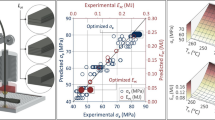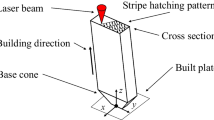Abstract
Recent advances in out-of-autoclave manufacturing processes for composite materials may require the compaction of the pre-preg plies just after placing them. Ultrasonic compactors are a good solution for this task. The quality of the compaction will depend on the frequency and amplitude of the ultrasonic vibration, which produces a viscous heating in the resin. The increase in temperature liquefies the resin, thus helping the air bubbles to escape. The study of how this heat is generated and distributed is fundamental to better understand and optimize the compaction process. In this work, the formulation of a thermomechanical model for the viscous heating of an uncured laminate of pre-preg plies due to ultrasonic vibrations is presented. In addition, a thermal model for the heat transfers to obtain the temperature distribution during the compaction process of composite layers will be shown.









Similar content being viewed by others
References
Mazumdar SK (2002) Composites Manufacturing. Materials, Product, and Process Engineering. CRC Press
Campbell FC (2003) Manufacturing Processes for Advanced Composites. Elsevier
Degrand H, Cazaux F, Coqueret X, Defoort B, Boursereau F, Larnac G (2003) Thermal effects on the network structure of diglycidylether of bisphenol-a polymerized by electron-beam in the presence of an iodonium salt. Radiat Phys Chem 68(5):885–891
Seebacher S (2008) Contributions to the investigation of in-situ ultrasonic tape lamination of composite thermoset prepregs. Master Thesis at the Private fachhochschule Göttingen
Justo J (2011) Curing out of autoclave: development and modelling of an ultrasonic debulking technique. Monograph of the EADS Chair of Aeronautical Studies of the University of Seville
Grewell D, Benatar A, Lee LJ, Zhou G, Lee E (2005) Development of an ultrasonic debulking technique for composite laminates introduction. Annual forum proceedings- American Helicopter Society 2:2085–2095
Roylance M, Roylance D, Nesmith K (1998) Use of Ultrasonic Tape Lamination for In-Process Debulking of Thick Composite Structures. Proceedings of the 43rd International SAMPE Symposium and Exhibition
Loud S (2000) Bridging the Centuries with SAMPE’s Materials and Processes Technology: Long Beach Convention Center, Long Beach California. Taylor & Francis
Roylance M, Player J, Zukas W, Roylance D (2004) Modeling of ultrasonic processing. J Appl Polym Sci 93:1609–1615
Justo J, Graciani E, París F, Chinesta F (2014) Study of the ultrasonic compaction process of composite laminates - Part II: Advanced numerical simulation. International Journal of Material Forming. Sent for publication
Justo J, Graciani E, París F, Ávila R (2010) Modeling of ultrasonic tape lamination. 14th European Conference on Composite Materials, Budapest, Hungary
Pfitzner J (1976) Poiseuille and his law. Anaesthesia 31(2):273–5
Wendl MC (1999) General solution for the couette flow profile. Phys Rev E 60:6192–6194
Temam R (2001) Navier–Stokes Equations. American Mathematical Society
Hori Y (2006) Hydrodynamic Lubrication. Springer
Chinesta F, Keunings R, Leygue A (2014) The Proper Generalized Decomposition for Advanced Numerical Simulations. Springer
Ammar A, Mokdad B, Chinesta F, Keunings R (2007) A new family of solvers for some classes of multidimensional partial differential equations encountered in kinetic theory modeling of complex fluids. Part II: transient simulation using space-time separated representations. J Non-Newtonian Fluid Mech 144:98–121
Chinesta F, Leygue A, Bognet B, Ghnatios C, Poulhaon F, Bordeu F, Barasinski A, Poitou A, Chatel S, Maison-Le-Poec S (2014) First steps towards an advanced simulation of composites manufacturing by automated tape placement. Int J Mater Form 7(1):81–92
Acknowledgments
The authors would like to thank the EADS Chair of Aeronautical Studies of the University of Seville and the ESI Chair of the École Centrale de Nantes.
Author information
Authors and Affiliations
Corresponding author
Rights and permissions
About this article
Cite this article
Justo, J., Graciani, E., París, F. et al. Study of the ultrasonic compaction process of composite laminates - part I: process modeling. Int J Mater Form 8, 613–623 (2015). https://doi.org/10.1007/s12289-014-1194-7
Received:
Accepted:
Published:
Issue Date:
DOI: https://doi.org/10.1007/s12289-014-1194-7




